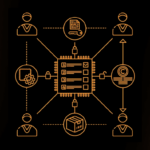Do you need a better explanation on all the iP versions and how IPs work? If yes, read on as this article is on the verge of explaining all the available Ip versions.
An IP address is a set of unique numbers that identify the device over the network. It is like a set of rules governing the data structure sent over the internet or through a local network.
With the increase in demand for IP addresses, the initial IP version no longer meets the requirement, which gave rise to a newer IP version.
If you want to learn more about how IPs work and understand their versions better, this post is for you.
Structure of an IP
IP addresses are displayed in a set of four digits. The default address can be 192.158.1.38. Every number on the set ranges from 0 to 255. This means that the total address range starts from 0.0.0.0 to 255.255.255.255.
Basically, an IP address is divided into two parts: X1. X2. X3. X4.
From X1 to X3 is the Network ID, while X4 is the Host ID.
Network ID
This is from X1. X2. X3. The part of the address identifies the specific network where the device is located. This means that where a device has an address of 123. 456. 7. 89, the 123. 456. 7. is the part of the address that is the network ID.
Host ID
The host ID is the part of the IP address that was not taken by the network ID. It identifies a particular device called the host. With our example of the IP address, 123. 456. 7. 89, the host ID will be 89.
IP Versions
There are two types of IP versions in use. They are IPV4 and IPV6
IPV4 (Internet Protocol Version 4)

This is the first version of the internet protocol address, and it is the most used address. This IPV4 uses a 32-bit length divided into four parts known as octets, each containing 8 bits. This address has been in existence since 1981.
IPV6 (Internet Protocol Version 6)
This is the most recent version of the internet protocol. This new address is organized to fulfill the need for more internet addresses. It was created to solve IPv4-related problems.
How IPs Work
While surfing the internet, you may encounter issues with the system’s address or the server side while web browsing is related to your internet connection. Nevertheless, how is the link created between your machine and the ISP?
This part of the post will help you understand how your system gets connected.
Steps on how our systems get connected.
- The first step begins with connecting your system, smartphone, and other network devices to the network device (wi-fi), which would indirectly link your device with the internet.
- The Internet Service Provider (ISP) is responsible for providing the connection if our device accesses the internet through our home network (ISP). A professional location, on the other hand, offers the network via the corporate network.
- The network now gives your system an IP address.
- When the system requests an internet connection, the ISP handles the request and uses the IP address to send the desired data back to the system. The ISP is responsible for giving an IP address to your device, which also initiates the internet connection to our system.
- The addresses given to the system are never stable. The address changes each time you use the network to access the internet. The ISP is responsible for this change. You can also contact your ISP to give your system an alternative IP address.
- In the event that you are traveling or are not connected to your home network, the internet connection made to the system is provided by a different network (public wi-fi, an airport hotspot, etc.), which gives the system a temporary address given by the ISP of the location network.
Conclusion
IP addresses are divided into a network ID and a host ID. The host ID is the part of the IP address that identifies a particular device, while the network ID is the part of the address that identity’s a specific network.
IP version 4 and version 6 are the two main versions of IPs. From the above discourse, I’m sure you’ve understood all the IP versions and how IPs work.
Read also: Your IP has been temporarily blocked; how to unblock your IP address.












